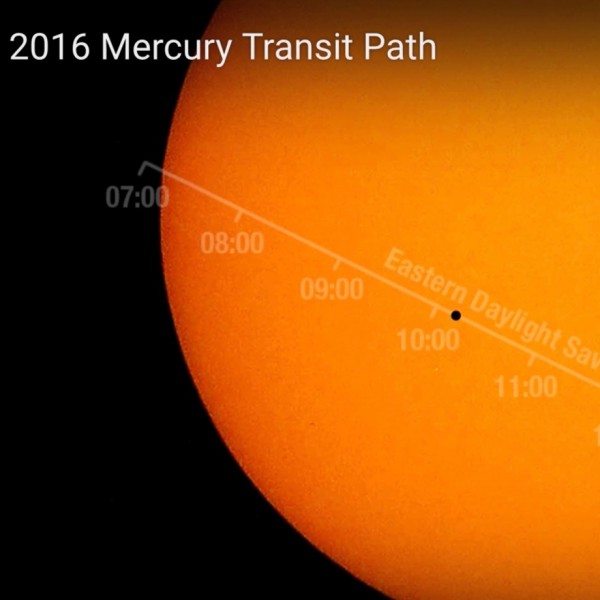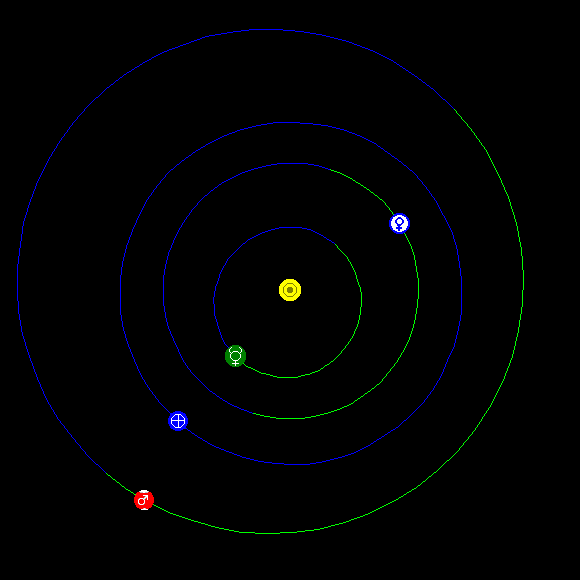
A transit of Mercury – the innermost planet of our solar system – is coming up on May 9, 2016! A transit occurs when Mercury passes directly in front of the sun. At such times, Mercury can been seen through telescopes with solar filters as a small black dot crossing the sun’s face. Mercury will come into view on the sun’s face at 7:12 a.m. EDT (1112 UTC). It’ll make a leisurely journey across the sun’s face, reaching mid-point at approximately 10:47 a.m. EDT (1447 UTC) and finally exiting at 2:42 p.m. EDT (1842 UTC). Translate to your time zone here. The entire 7.5-hour path across the sun will be visible across the U.S. East – with magnification and proper solar filters – while those in the U.S. West can observe the transit in progress after sunrise. Play the video and follow the links below to learn more about the May 9, 2016 transit of Mercury.
How to watch the May 9 transit of Mercury online
How often do transits of Mercury happen?
What part of Earth will see the May 9 transit of Mercury?
Equipment needed to watch a Mercury transit
May 9 transit times in Universal Time
Mercury transit times for select North American cities in your local time
Transit contact times for many more North American cities via Fred Espenak’s EclipseWise.com
Dates for transits of Mercury in the 21st century (2001 to 2100)
Transit of Mercury on May 9, 2016 from LarryKoehn on Vimeo. Visit Larry’s great website shadowandsubstance.com

How to watch the transit of Mercury online.
Watch the transit of Mercury online via Virtual Telescope Project (starts May 9 at 7 a.m. EDT, or 11 UTC)
Watch the transit of Mercury online via Slooh (starts May 9 at 7 a.m. EDT, or 11 UTC)
NASA will provide coverage of the transit via several avenues.
– A live program on NASA TV and the agency’s Facebook page from 10:30 to 11:30 a.m. ET (1430-1530 UTC). This informal roundtable will offer experts representing planetary, heliophysics and astrophysics who discuss the science behind the Mercury transit. Viewers can ask questions via Facebook and Twitter using #AskNASA.
– Images from NASA’s Solar Dynamics Observatory (SDO) will be posted at: https://www.nasa.gov/transit
Click here to find a public presentation of the Mercury transit near you
How often do transits of Mercury happen?
Although much more common than transits of Venus, transits of Mercury happen only 14 times in the 21st century (2001 to 2100).
Transits of Mercury always occur in either May or November.
The last three were in 1999 (November 15), 2003 (May 7) and 2006 (November 8); the next will be on May 9, 2016, and the next after that will be November 11, 2019.

What part of Earth will see the May 9 transit of Mercury? As shown on the worldwide chart above, the transit will be visible (at least in part) from most of the globe, with the exception of shaded-out portion (Indonesia, far-eastern Asia, Australia and New Zealand). Mercury takes some 7.5 hours to cross the sun’s disk, and this transit of Mercury is entirely visible (given clear skies) from the eastern half of North America, most of South America, Greenland, Iceland, far-western Africa, western and northern Europe, plus the Arctic.
For North America, the transit begins in the early morning hours on May 9. The eastern part of North America sees the start of the transit after sunrise May 9, whereas the western part sees the transit already in progress as the sun rises on May 9.
As for the world’s Eastern Hemisphere – Africa, Europe, Middle East and Asia – the transit starts around noon May 9 in the westernmost parts of Africa and Europe, and in the late afternoon May 9 in eastern Asia (China, Mongolia, Thailand). In western Asia and eastern Africa, the transit begins around mid-afternoon May 9.

Equipment needed to watch a Mercury transit. Mercury’s diameter is only 1/158th of that of the sun, as seen from Earth. That’s why eclipse master Fred Espenak recommends using a telescope with a magnification of 50 to 100 times for witnessing the event.
Plus your telescope must be equipped with a safe solar filter to safely watch this transit, or else you risk permanent eye damage. Click here to learn how to view the sun safely
Click here to find a public presentation of the Mercury transit near you
Click here to learn how to watch the Mercury transit online

May 9 transit times in Universal Time
We provide the geocentric (Earth-centered) contact times of the transit of Mercury in Universal Time (UT). If you know how to convert Universal Time to your local time (here’s how to do it), you can get a good approximation of the contact times for the Mercury transit for your part of the world. NOTE: Because the transit is viewed from the Earth’s surface, instead of the Earth’s center, the contact times could differ from the geocentric contact times by up to a minute.
First contact (ingress, exterior): 11:12:19 UT
Second contact (ingress, interior): 11:15:31 UT
Greatest transit: 14:57:26 UT
Third contact (egress, interior): 18:39 UT
Fourth contact (egress, exterior): 18:42:26 UT
Mercury transit times for select North American cities in your local time
The times below are in your local time (meaning no conversion is necessary). We give transit contact times for various North American cities and Honolulu, Hawaii.
NOTE: All places within the same time zone have very similar contact times.
Newfoundland Daylight Time (NDT)
St. Johns, Newfoundland:
First contact (ingress, exterior): 8:43:17 a.m. NDT
Second contact (ingress, interior): 8:46:29 a.m. NDT
Greatest transit: 12:27:26 p.m. NDT
Third contact (egress, interior): 4:07:14 p.m. NDT
Fourth contact (egress, exterior): 4:10:59 p.m. NDT
Atlantic Daylight Time (ADT)
Halifax, Nova Scotia:
First contact (ingress, exterior): 8:13:26 a.m. ADT
Second contact (ingress, interior): 8:16:38 a.m. ADT
Greatest transit: 11:57:38 p.m. ADT
Third contact (egress, interior): 3:37:58 p.m. ADT
Fourth contact (egress, exterior): 3:41:10 p.m. ADT
Eastern Daylight Time (EDT)
New York City, New York:
First contact (ingress, exterior): 7:13:34 a.m. EDT
Second contact (ingress, interior): 7:16:46 a.m. EDT
Greatest transit: 10:57:54 a.m. EDT
Third contact (egress, interior): 2:38:12 p.m. EDT
Fourth contact (egress, exterior): 2:41:23 p.m. EDT
Central Daylight Time (CDT)
New Orleans, Lousiana:
First contact (ingress, exterior): 6:13:34 a.m. CDT
Second contact (ingress, interior): 6:16:58 a.m. CDT
Greatest transit: 9:58:25 a.m. CDT
Third contact (egress, interior): 1:38:42 p.m. CDT
Fourth contact (egress, exterior): 1:41:53 p.m. CDT
Mountain Daylight Time (MDT)
Denver, Colorado:
First contact (ingress, exterior): sun below horizon
Second contact (ingress, interior): sun below horizon
Greatest transit: 8:58:18 a.m. MDT
Third contact (egress, interior): 12:38:46 p.m. MDT
Fourth contact (egress, exterior): 12:41:57 p.m. MDT
Pacific Daylight Time (PDT)
Los Angeles, California:
First contact (ingress, exterior): sun below horizon
Second contact (ingress, interior): sun below horizon
Greatest transit: 7:58:31 a.m. MDT
Third contact (egress, interior): 11:39:08 a.m. MDT
Fourth contact (egress, exterior): 12:41:57 a.m. MDT
Alaska Daylight Time (AKDT)
Anchorage, Alaska:
First contact (ingress, exterior): sun below horizon
Second contact (ingress, interior): sun below horizon
Greatest transit: 6:57:31 a.m. AKDT
Third contact (egress, interior): 10:38:08 a.m. AKDT
Fourth contact (egress, exterior): 10:41:53 a.m. AKDT
Hawaii-Aleutian Standard Time HST)
Honolulu, Hawaii:
First contact (ingress, exterior): sun below horizon
Second contact (ingress, interior): sun below horizon
Greatest transit: sun below horizon
Third contact (egress, interior): 8:39:58 a.m. HST
Fourth contact (egress, exterior): 8:43:10 a.m. HST

Transit contact times for many more North American cities via Fred Espenak’s EclipseWise.com
Canadian Cites (Alberta – Northwest territory)
Canadian Cites (Nova Scotia – Ontario)
Canadian Cities (PEI – Yukon Territory)

What causes a transit of Mercury?
Only planets that orbit the sun inside of Earth’s orbit – Mercury and Venus – ever transit the sun, as seen from Earth. If Mercury orbited the sun on the same plane that Earth does, there would be three to four transits of Mercury each calendar year.
However, Mercury’s orbital plane in inclined at 7o to the ecliptic (Earth’s orbital plane). That means when Mercury swings in between the Earth and sun at inferior conjunction (see illustration below) every four or so months, Mercury usually sweeps to the north or south of the solar disk. Therefore a transit of Mercury is fairly rare, only happening 13 to 14 times per century.
Each time Mercury circles the sun in its short and swift orbit of 88 Earth-days, Mercury travels north of the ecliptic (Earth’s orbital plane) for about half its orbit, and south of the ecliptic during the other half of its orbit. Twice in its orbit, Mercury crosses the Earth’s orbital plane at points called nodes. When Mercury is traveling from north to south, it’s called a descending node; and when Mercury is traveling south to north, it’s called an ascending node.
Whenever Mercury crosses a node in close vicinity to reaching inferior conjunction, a transit of Mercury is not only possible but inevitable. Mercury crosses its descending node nearly concurrently with Mercury at inferior conjunction on May 9, 2016, to present a rather rare transit of Mercury.
Descending node transits can only happen during the first half of May, and ascending node transits in the first half of November. At other times of the year, Mercury at inferior conjunction would either pass north or south of the sun’s disk.

Dates for transits of Mercury in the 21st century (2001 to 2100). All Mercury transits happen in either May (descending node) or November (ascending node).
May 7, 2003
Nov 8, 2006
May 9, 2016
Nov 11, 2019
Nov 13, 2032
Nov 7, 2039
May 7, 2049
Nov 9, 2052
May 10, 2062
Nov 11, 2065
Nov 14, 2078
Nov 7, 2085
May 8, 2095
Nov 10, 2098
November (ascending node) transits happen about twice as often as May (descending node) transits. This is because Mercury has a very eccentric (oblong) orbit whereby Mercury comes a whopping 24 million kilometers (15 million miles) closer to the sun at perihelion (closest point to the sun in its orbit) than at aphelion (farthest point). In May, Mercury is rather close to aphelion, and quite far from the sun, which severely narrows the window of opportunity for a May transit. In November, Mercury swings rather near perihelion, and quite close to the sun, widening the period of time during which a November transit is possible.
Mercury transit cycles. Note that after a May transit, a November transit faithfully comes 3.5 years later (for instance: May 9, 2016 and November 11, 2019). Transits recur on nearly the same date in cycles of 46 years (for instance: May 9, 2016 and May 10, 2062). November transits, which are more common than May transits, occasionally recur in periods of 7 years, and more frequently in periods of 13 and 33 years.
May transits, which are less common than November transits, frequently recur in periods of 13 and/or 33 years. The 46-year cycle represents a combination of 13 and 33 years (13 + 33 = 46).
Seven century catalog of Mercury transits: 1601 CE to 2300 CE
Bottom line: Our solar system’s innermost planet, Mercury passes directly in front of the sun on May 9, 2016. Who will see it, how to watch, equipment needed, transit times.











